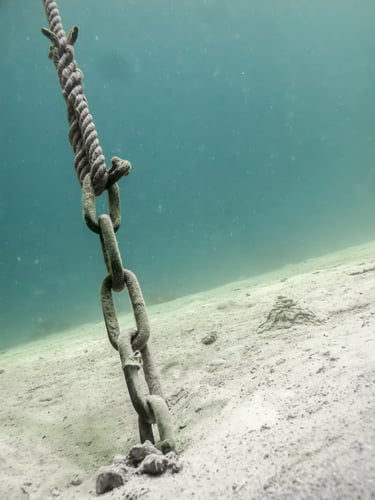One of the oldest and most basic pieces of equipment found aboard any boat is the anchor. Some of the earliest anchors discovered by archeologists date back over 2,500 years to the Sea of Galilee, and they were little more than circular, heavy stones with holes drilled through them to attach a rope.
A simple yet effective invention, motivated perhaps by the rumor that seamen of old hated the job of pulling the anchor almost as much as boaters do today. For this reason, an enterprising mariner invented the earliest windlass, which consisted of a wooden wheel with a lever attached so the anchor could be wound to the surface instead of pulled up by hand.
Pulling an anchor off the bottom hand-over-hand in the best of conditions is a lot of work. Add the pressure of moving water or heavy currents, like when anchored in a river or near an inlet, and your work is compounded. If you anchor in deep water, the amount of rode can easily become hundreds of feet, making it more work still. Properly rigged ground tackle—that’s boater’s jargon for a properly assembled anchor system—not only has a heavy anchor to contend with, but also a significant length of chain, which helps the anchor establish a good bite on the bottom and maintain the proper angle between the anchor and the boat so it maintains its grip.
If you were to do a survey of recreational boats today, you would find that most do not have an electric windlass so we are still in the era of pulling anchors by hand…or are we? There is a simple method of raising your anchor off the bottom that uses the power of your boat’s engine to accomplish the task. Better yet, it is inexpensive, easy to use, works under any conditions and can retrieve an anchor no matter how deep the water, how strong the current or how long the rode.
Say hello to the Anchor Retrieval System (ARS). It is extremely popular among saltwater anglers who use one or two sets of ground tackle when bottom fishing and anglers who bottom fish on inland rivers. But the system is growing in popularity among the general boating public, too.
An ARS consists of four components: a vinyl tuff-end buoy that has a large line-hole attachment point; a short length of line; a stainless steel spring clip and a device called, appropriately enough, an anchor ring. The size of the buoy corresponds to the weight of the anchor and chain, since it must offer enough buoyancy to float the weight to the surface. When you use the components together, one end of the line is attached to the line hole of the buoy and the other end attaches to the spring clip. These connection points are usually accomplished by splicing the braided line, but you can buy the system pre-assembled so there are no worries about having to learn rope craft.
The following pictures were shot aboard the Duct Work, a Yamaha-powered 31-foot Cape Horn® center console during a bottom fishing trip with Capt. Phil Leo. The ARS was used numerous times during the day to effortlessly retrieve a large Danforth® anchor and long length of chain from as deep as 130 feet down.

- When it’s time to pull anchor, either pull up on the rode by hand or use the engine to slowly move the boat forward so you can bring a section of the rode alongside. Slip the anchor ring around the rode.

- Slip the spring clip through both loops on the anchor ring effectively closing the circle and toss the buoy overboard. Wrap the rode around the spring line cleat on the boat.

- Carefully power forward, angling slightly away from the position where the anchor was dropped creating a loop in the rode between the boat, the buoy and the anchor.
- At a slow speed, run the boat forward past the anchor point. As you get further away from the anchor point, the rode will come tight to the buoy and will break the anchor free from the bottom.
- As you continue forward, the rode will slide through the anchor ring and the buoy will be bouncing on or slightly under the surface.
- The anchor will come to the surface and be captured inside the anchor ring. When this happens, the buoy will bounce more violently and swerve from side to side.
- Stop the boat and turn the boat back toward the buoy retrieving the rode as you drive or drift slowly back to the buoy.
- When the buoy is almost alongside the boat, cautiously lift the chain and anchor aboard being careful not to scrape or ding the gel coat.
The whole procedure takes considerably less time and effort than lifting the anchor by hand, and is much easier on the arms and back of the poor soul assigned to “weigh anchor.”
You can pick up an ARS at most marine stores or online for about the cost of an anchor. If you use your anchor with any regularity, it will be the best money you’ll spend on boating all year.
Anchor Terminology:
ARS – Anchor Retrieval System
Ground Tackle – all the components that make up the boat’s anchor system
Line – rope
Rode – the line stretched between the anchor and the boat
Splice – the method used to create a loop or insert an eye in a piece of braided line or to connect two pieces of braided line
Weigh Anchor – raise the anchor

